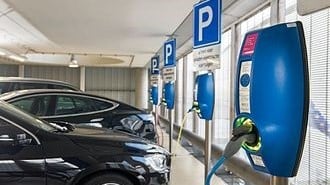Low Carbon Fuel Credits (LCFS) for CA Multifamily Owners Who Install EV Chargers

4 MIN. READ
EV charging stations are an excellent benefit for multifamily property tenants and managers. They offer convenience for residents, and they can provide a new source of revenue for owners, but their installation can come with significant expenses. As a property owner or manager, you can apply for incentives and rebates, such as Low Carbon Fuel Credits (LCFCs) to offset costs and help you with spending control.
What are LCFCs?
Low Carbon Fuel Credits (LCFCs) originated in the State of California Low Carbon Fuel Standards (LCFS) in 2007 under Executive Order S-1-07.
Subsequently, in 2009, California established a portfolio of measures to reduce carbon (greenhouse gas) emissions. That portfolio of standards is referred to as AB32 or the AB 32 Scoping Plan, and the program is administered by the California Air Resources Board (CARB).
The executive order applies to the sale or supply of any fuel in California. Two of the main goals of the LCFS are:
- To introduce less carbon-intensive (CI) fuels that generate fewer greenhouse gases, like carbon dioxide and methane. Examples of such fuels are hydrogen, biofuels, and electricity from the grid to charge EVs. On the other hand, fuels like diesel and gasoline emit much more carbon and other greenhouse gases.
- To reduce the carbon intensity of transportation fuels by 20% by 2030.
To incentivize low-CI fuels and discourage the use of high-CI fuels, the LCFS grants fuel credits to generators of low-CI fuels and “tax” producers of high-CI fuels. So, by exchanging electricity from EV chargers for gasoline, you may create a credit, but doing the opposite would create a deficit or a cost to you. A credit must offset that deficit.
To put it in perspective, one credit equals one metric ton of carbon removed from the air.
How does the program work?
The State of California establishes a set of benchmarks annually for each type of fuel based on a standard calculation of carbon intensity. High-CI fuels have a higher bar. The models are based on the total amount of carbon generated in the fuel life cycle from generation through consumption.
If the new fuel has a lower benchmark (lower CI) than the original one, credit is created. If it has a higher standard, a deficit is charged. The state calculates these credits and debits for you based on usage reports you must file.
If a producer or supplier incurs a deficit, the producer must purchase an offsetting credit from another party with accrued credits. As a result, The LCFS credit price fluctuates with demand.
LCFS credit price for EVs
Since EV chargers use electricity from the grid, which has a lower CI than gasoline, EV charger owners can claim a credit.
Credits are generally used only for reinvestment in or operation of EV infrastructure or services. They can be sold to carbon credit offset brokers or assigned or sold to other entities.
LCFS credits for EV infrastructure are based on the quantity of energy provided by chargers. Notably, EV projects can generate significant credits depending on the LCFS credit price, especially at high-volume sites. For example, the value of credits ranged from $65 in 2016 to $200 in 2019, and in 2021, the average value was $199 per credit per year per vehicle charged.
As an example, an EV charging site with 10 vehicles could generate approximately $15,400 annually. In some cases, the costs of installation are subject to credits.
How to participate
Consider the following questions to determine whether you can obtain LCFS credits.
Do you qualify?
In general, any entity that produces or distributes fuel in California qualifies. Charging station owners qualify since they distribute electric grid energy as fuel to EV batteries.
To confirm that you qualify for Low Carbon Fuel Credits, you must apply to the State of California Air Resources Board. The process can be detailed, so consider enlisting expert help and pay special attention to reporting requirements.
Which states offer these programs?
Currently, California leads in LCFS implementation, but Oregon and British Columbia (Canada) also have programs. Numerous other U.S. states are considering Low Carbon Fuel Standard credits, including Washington, Colorado, South Dakota, Minnesota, Iowa, and New York. In addition, virtually all other Canadian provinces are looking at LCFS.
Watch the latest news about your LCFS credit price
The world of low carbon fuels, Low Carbon Fuel Standard credits, and other incentives, like rebates, is constantly in flux. The knowledge base is growing, so keep on top of new developments in your state.
- Incentives and rebates come and go.
- The LCFS credit price (and value) is constantly changing as demand shifts.
Consult websites or blogs for developments in U.S states. In addition, track the California LCFS credit price and keep an eye on Federal Programs.
In summary
Low Carbon Fuel Credits offer substantial value to multifamily property owners and facility managers who install EV charging stations in California. The trend toward such incentives is spreading across the U.S. and Canada, and you can take advantage by getting savvy about LCFCs to capture their value for your EV charging project.
Importantly, stay on top of developments since the LCFS credit price is dynamic and results in varying value for your EV project. Eligibility, application, and reporting requirements may change.
If you decide to install EV charging stations on your property, you will need outside contractors. Selecting high-quality, reliable contractors is crucial, and so is a reliable supply chain for parts and equipment. We would recommend Qmerit, the leading EV charger installer in North America.
Raiven Can Help
Raiven serves multi-family property managers with the lowest prices on equipment, parts, and maintenance supplies as well as a purchasing platform that makes buying fast and efficient. Key benefits include:
- Pre-negotiated discounts of 7-25%+ from big name suppliers like Carrier, Ferguson, Grainger, Graybar, Home Depot, Lowe’s, and more.
- Supply chain alerts for price and product availability changes on the items that matter to you most.
- Private marketplace houses all your preferred suppliers in one location for easy access to your discounts. No more bouncing around websites comparing prices.
- AI-powered purchasing tools that find the lowest prices even when employees shop outside your preferred suppliers.
Raiven is your one stop to save time and money. Visit Raiven to learn what we can do for you.


